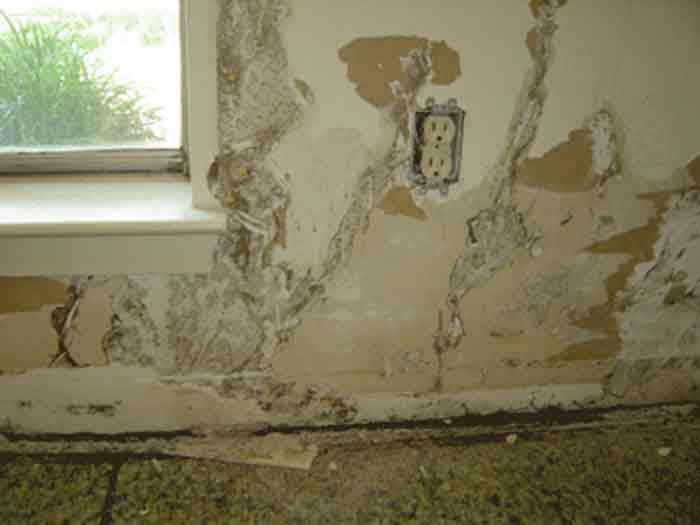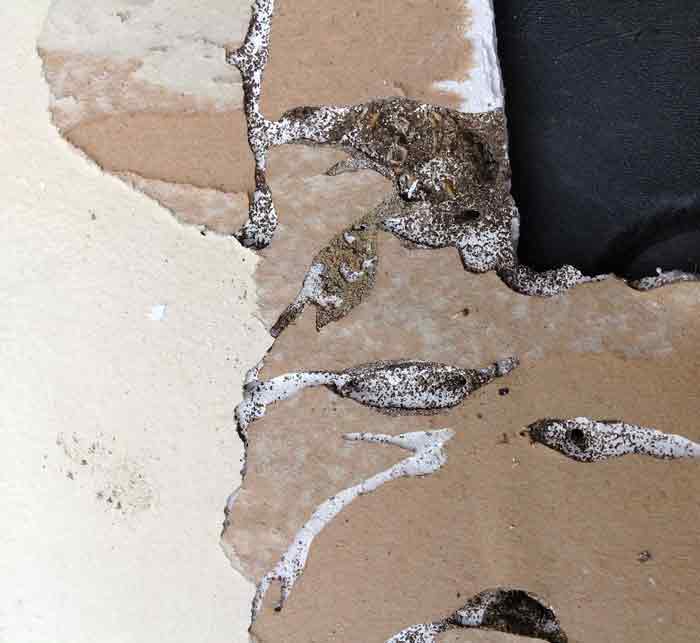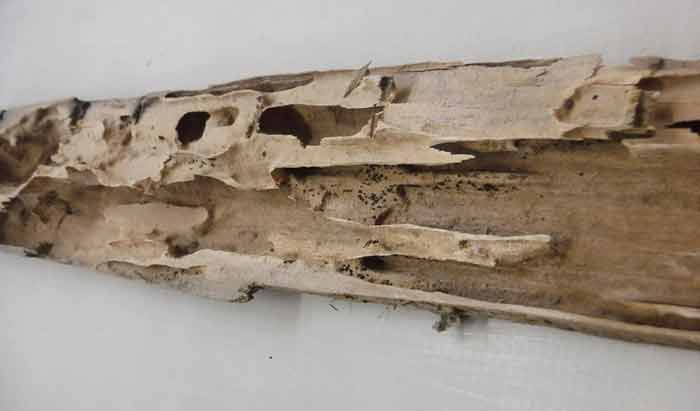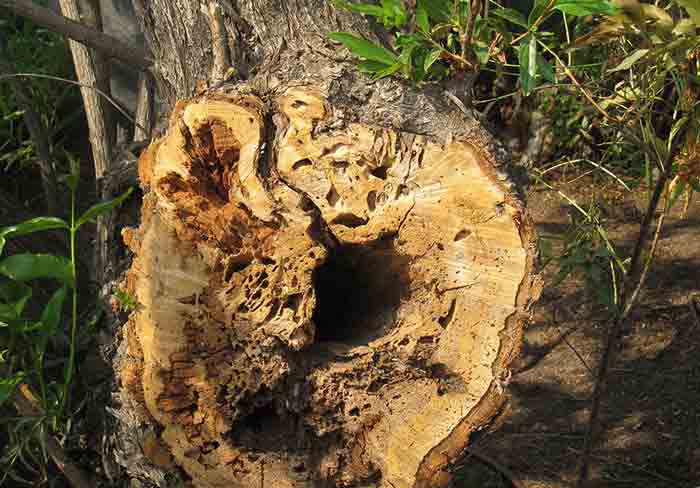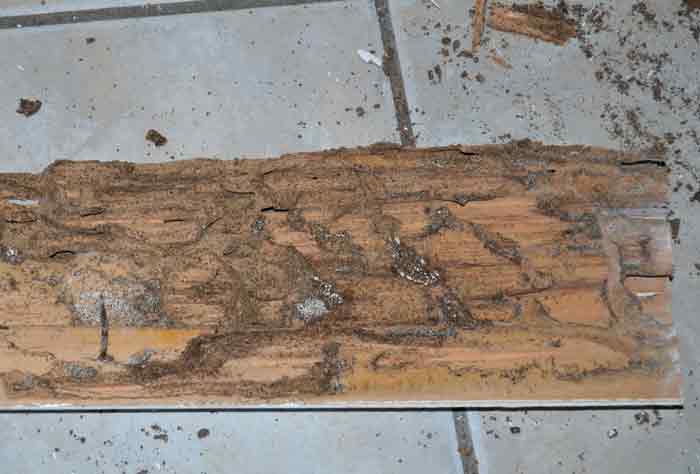Termites cause so much damage to your home and could bring down the entire structure holding up your house. Find out how destructive these insects are, how fast they can cause the damage, pictures of how it looks like, how to repair and the associated costs of the fix.
It is reported that termites cause so much damage to human homes with the damage ranging between one to two billion.
In most cases, the damage caused by termites is not covered for by insurance policies. You may not discover the presence of termites until you see how much damage they cause.
Termites cause structural damage. There are several structures that are destroyed by termites including; floors, posts, support beams, wall studs, ceiling joints, drywall or sheetrock, foundations, roof supports, and attics.
Table of Contents
What does a termite Damage look like?
A destruction that results from termites looks quite distinct.
One of the things you will see is large galleries tunnels that were made as the termites ate the wood. The galleries host termite nest and they are connected with tunnels.
More often than not, the destruction, especially if it is from drywood termites, goes both along and across the grain of the wood and is accompanied with mud that is used as a moisture source for the termites.
Shelter tubes is another feature that describes a damage. The mud is the building material for shelter tubes.
According to experts from Orkin, in a cross section of subterranean termite-damaged wood, summerwood has a honeycomb appearance after the springwood has been eaten. Length-wise, summerwood looks like thick sheets of paper after the springwood has been eaten.
Termite Damage Pictures
Drywall
Drywood termite damage pictures
Damage on tree photos
Signs of damage
On examining your house, you can point out some signs that show your house has been damaged by termites.
To begin with, you may notice that your floors as well as ceilings appear sagged, there may be wings that have piled up, some areas that look like they have been damaged by water, and some dust like traces.
If you notice openings on your wood, it is also a sign that termites continue to cause damage on the wooden structures.
You may also realize that your wooden structures start to be weak and hence are unable to support themselves. This happens when the termites eat not of the timber which makes up the structures.
How fast can termites cause damage
The rate at which the termites will cause damage depends on a number of factors. Some of them are discussed below;
Colony size
The larger the termite colony the faster is the rate at which the termites feast on your property. These termites will feed on different parts of your wooden structures making the damage thorough and very fast.
In fact, the number of termites infesting your home is of greater importance when determining the speed of destruction as compared to the rate at which an individual termite feeds.
Studies show that a termite colony matures after about one to two years before it becomes a fully mature colony.
A single fully-grown termite colony is estimated to cause a serious damage to your home within six months. If your home is about 23000 square feet and has an approximate of 17000 feet of lumber, it will take 8500 years for them to eat your entire home.
Location and climate
How active a termite is depends on the climate for some termite types. The climate can be warm or cold. Termite activity has been found to be thorough when there is a warm climate than if it is cold.
If you live in a warm area therefore, you will have the termites cause the damage at a faster rate. Termites living in cold areas were found to feed sluggishly and hence take a very long time to cause damage.[1]
Termite Damage Repair/Fix Cost
What factors will determine the cost
The cost of treating termites varies from one home owner to another. This may be determined by a number of factors as discussed below;
Extent of infestation
A more developed colony is likely to infest your entire home while a young termite colony may only cause destruction in a small portion of your home. This results to a difference in the cost of treatment since it is easier to treat a young termite infestation than it is to treat a fully grown termite colony infestation.
Where the termite colonies are wide spread, the cost goes even higher. It is therefore advisable that you seek termite treatment as soon as you spot even the smallest infestation as that would grow within a very short time and cause more damage than you can afford to treat.
The square footage of your home
The bigger your home is, the higher will be the cost of treatment if the home is infested with termites. The increased cost is explained by the increased hours of inspection as well as the treatment coverage if excellent results are to be attained.
Foundation of the house
Professionals explain that some houses are built on foundations which if infested with termites, they will require a customized treatment. Such foundations include those made using monolithic slabs. This in turn means that you incur a higher cost. That aside, if your business has a basement or a crawl space, it will cost you relatively more than it would if the treatment was on a normal structure.[2]
Damage done
How much you pay for termite treatment will also depend on how much damage the termites have caused. The more damage the termites cause the more the cost incurred in correcting the damage.
Treatment method
There are various methods of carrying out termite treatment. These methods vary in how much they cost. The most effective treatment methods of termite infestation are very expensive. You can always go for the treatment method which is affordable but effective.
Frequency of pest control companies
If you have pest control companies visiting your home frequently, they in most cases establish easy ways of pest control making termite treatment easier and cheaper.
What is the average cost?
The average cost of treating termites is estimated to be $2000 to $5000. This will however vary depending on the factors discussed above.
The cost of termite treatment constitutes of the inspection cost, the actual treatment and the cost incurred in doing the follow up plan.
Ceiling
When termites cause damage to your ceiling, their damage resembles water damage. When the ceiling is damaged, it begins to sag and buckle. The most common culprits of ceiling destruction are subterranean termites and drywood termites.
When drywood termites swarm into your house and make a home in the attic space or on your ceiling.
Subterranean termites also manage to get to the ceiling even though they live underground. Usually, they create mud tubes and use them to slowly go up to your ceiling space.
As soon as you see mud tubes going up the walls of your house, you are advised to examine your house as it may be an indicator that more serious damage has been done to your house.
There are several ways through which you can spot termite damage on your ceiling. Some of the signs include;
Termite droppings
Fecal matter pushed out of the nest of the termites could be used as evidence of termite infestation on your ceiling. Drywood termites for instance leave frass which refers to some small brown fecal pellets.
Cracks on ceilings
Another way to tell if the termites have gotten into your ceilings is if you see some cracks on the ceiling.
The reason cracks occurs on the ceiling structure made of timber is explained by the shifting of the wood as the termites feast.
Piles of wings
In the case where the drywood termites swarmed recently, piles of termite wings may be left on your ceiling.
Mud tubes
Where you spot mud tubes along your walls, follow to see how far they go as they may be tunneling to your ceiling. This is usually in the case where the infestation is by subterranean termites.
Hardwood Floors & Trees
Termites are not picky as long as they get cellulose from the wood. This explains why termites do not care whether the wood is soft or a hardwood.
You must remember that hard and soft wood are not a description based on how hard or soft the wood.
The difference between hard and soft woods is basically botanical and termites will destroy the two classes of plants equally.
You cannot therefore differentiate the level of damage that termites cause to hardwood from that of soft wood.[3]
How to treat termite damaged wood
Termites cause too much damage on wood in their search for cellulose. Where the wood is not totally destroyed, you can fix the damage. There are many ways of treating termite damaged wood and they include the following;
- Use termite wood filler (discussed below in details) rather than a wood hardener.
- In case the termites have caused the wood to rot, remove the rotten part of the wood using a chisel.
- Restructure the wood by for instance offering it support if it had started to rot.[4]
Wood filler for termite damage
Also referred to as plastic wood, wood filler is produced in various companies as a solution to fixing termite damaged wood. Wood fillers are available in both non-solvent and solvent forms.
The non-solvent wood filler being preferred for indoor use since it does not produce any harmful vapors. The wood filler will be most helpful in the case where the termite damage involves gouges and holes in wood.[5]
What damages do they do to trees?
Termites damage trees by creating holes, feeding on the timber making up the trees and eventually cause falling of an entire tree. Whether the tree is living or dead, termites will feed on the tree anyway and cause a lot of damage.
Subterranean vs DrywoodTermite Damage
Compared to drywood termites, subterranean termites cause more damage. Firstly, this can be explained by the fact that drywood termites are found in relatively smaller colonies as compared to subterranean termites. The smaller and the slower a termite colony grows the less is the resulting damage.
The damage caused by drywood termites becomes more severe when they swarm and spread to different parts of your home.
Therefore, as much as the drywood damage cause less damage compared to the subterranean species, they must be taken care off since although they take a lot of time to cause destruction, the damage they cause may be very costly.
Subterranean termites on the contrary are known to cause so much damage due to their big colonies.
Additionally, their colonies grow very fast and this increases the extent to which they damage your home.
In the United States, they are estimated to cause more damage than storm and fire would.
Termite damage but no termites
If you realize that there is evidence of termite damage but you cannot locate the termites, it could mean that the damage was caused by an old infestation which does not exist anymore.
That aside, it could also mean that you have an inactive termite infestation where the termites cause damage silently and go away so that they cannot be seen.
In some cases, you may confuse damage caused by other pests for termite damage and that could actually be why no termites are actually found upon inspection.
Always equip yourself with the knowledge needed to differentiate termites from other pests.
Termite damage vs water damage
You’ve already learnt how a termite damage looks like.
Water damage some times referred to as dry rot or pocket rot comes about when wood is constantly in contact with moisture, rain water or the ground.
The wood absorbs the water into the cells within the wood. The cells then expand and explode once they are full and can no longer suck more water.
In terms of appearance, the damage creates square-shaped cells in the wood These square-shaped cells come as a result of the expansion cracking from the excess water content.
It is also important to note that some species of termites(dampwood) prefer wood that has already been exposed to water. It is recommended that you find a specialist to help out.
Does Homeowners insurance cover termite damage?
Generally, termite damage is not covered by homeowners’ insurance policies. This is because, this cover is meant to be for risks that are sudden and unavoidable and not for damages caused by pests.
Termite damage is taken to be something you can prevent or control. Nevertheless, there are two cases where the homeowners’ insurance cover can take care of termite damage. These circumstances include the following;
- When the entire house collapses following a termite infestation about which you had no idea. You will only be compensated for the damage if you totally knew nothing about the existence of the termites in your home.
- Where a risk against which you are covered causes the termite infestation. This includes cases where termites are caused by moisture accumulation which may be caused by water leakages. If your home insurance policies cover water leakages, you may consider yourself lucky as the damage caused by the termites can be paid for by your insurer.[7]
Further Reading
- Termite Baits, Stations & DIY Traps
- Dampwood termites Pictures, Damage & Treatment
- Termite Tenting & Fumigation- Cost, Preparation, Safety & Cleaning After
- Termite Barriers (Shields): Types, Cost, how they Work & Products
- Termites Damage, Pictures, Repair Cost, Ceiling, Floors, Wood & Fix
- Best Termite Sprays-Orange Oil (DIY), Boric Acid & Spectracide Reviews
- Termites Life Cycle & Span-Eggs, Larvae, Baby & Adults
- How to Prevent Termites-Tips to Protect your Home
- Signs of Termites Infestation-How do you know if have you them?
- What do Termites look like? Pictures, Size, Color & Look-alikes
- Termites: Where From, Habitat, Eat, Noise, Types +more!
- Subterranean Termites Swarmers Treatment Cost, Damages & Pictures
- Flying Termites with Wings (Swarmers) Pictures & How to get Rid
- Termite Droppings-Drywood, what they look like, Health Risks, Clean vs Sawdust
- Formosan Termites Pictures, Signs Treatment & Damage
- How to Get Rid, Kill Termites + Treatment Cost
- What Causes & Attracts Termites?
- Do Termites Bite Humans? Pictures & Remedies
- Flying Ants vs Termites-Differences & Similarities
- Termite Inspection Cost, Procedure, how long it takes & Training
- Termite Colony-Queen, Soldier, Worker & King
- Drywood Termites Treatment Cost, Get rid & Damage
- Termite Bond Cost, Benefits
References
[1] https://www.orkin.com/termites/how-fast-do-termites-eat-wood/
[2] https://killtermitesguide.com/termite-treatment-cost/
[3] https://dentecpest.com.au/hardwood-termites-rumors-true/
[4] https://www.mrhandyman.com/blog/2013/august/repairing-wood-damage-from-termites-ants-and-other-insects/
[5] https://www.hunker.com/12617004/recommended-wood-filler-for-termite-damaged-wood
[6] http://www.inspectallservices.com/news/what-exactly-is-a-termite-bond
[7] https://www.valuepenguin.com/does-homeowners-insurance-cover-termite-damage
